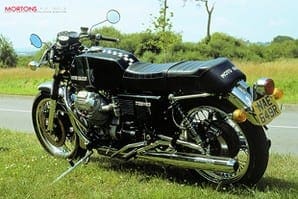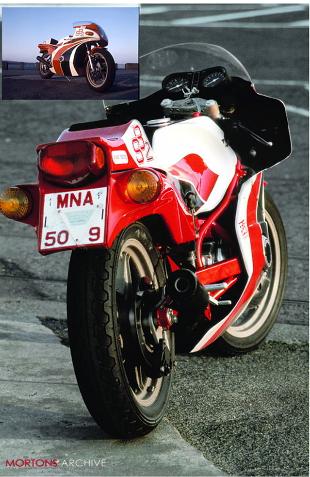
Italian motorcycles have always been loved for their singular character. Like most Italian design, they have been the result more of passion than a desire for business success. It is only recently that Italian motorcycle manufacturers have enjoyed financial security, and that is ironically largely due to massive foreign investment.
In the 1970s though the Italian motorcycle industry was passing through its own renaissance, spurred on by competition from the Japanese that had fired increasing demand worldwide for high-performance machines and a growing vacuum created by the collapse of the British industry.
Enjoy more Classic Motorcycle Mechanics reading in the monthly magazine.
Click here to subscribe & save.
So the Italian superbikes of the period represent a watershed of traditional design reaching its zenith. Marvel at their style and simplicity…
Moto Guzzi 750-S3
If ever there was an engine made to fit perfectly into a motorcycle chassis it was Moto Guzzi's 90-degree vee-twin. Mounted so that the crankshaft was in line with the wheels, it was narrow across the crankcases yet the giant cylinders never interfered with the ergonomics or the cornering.
Power was delivered simply through a dry car-type clutch to the five speed gearbox and shaft drive.
It's an elegant design that lends itself to the stylist's pen so easily, yet the engine was never intended for a bike at all. It was originally intended for a strange three-wheel mountain vehicle called the 3×3 made for the Italian government over three years from 1960. In 1964 it was adapted for a military motorcycle and the factory realised it would be ideal for a civilian machine.
The first Moto Guzzi to use a derivation of this was the portly and slow V7, a touring machine that was a far cry from the world championship-winning Guzzi racers of the fifties. Guzzi's racing greer returned in 1972 with the V7 sport that boasted a low and lean chassis am could reach 115mph.
My own favourite is the 750-S3 that arrived in 1975, but still only in very small numbers in the UK through specialist dealers. The 750-S3 came it black with red flashes on the tank and side panels, with wire-spoked wheels featuring massive disc brakes.
The 750-53 was no rocket ship with a modest 115mph top speed but ii made up for that with uncanny smoothness at speed and with a large flywheel enabled relaxed long-distance riding, made all the more feasible with a big fuel tank giving a 240 mile range.
It's also a simple and easily maintained machine with plenty of spares sources.
 MV Agusta 750S
MV Agusta 750S
If riding a classic Italian thoroughbred is an elevating experience, then riding an MV Agusta is riding with the gods. The badge on the top of the fuel tank says enough: '37 Volta Campione del Mondo' but it's more than just a racing heritage that makes the four-cylinder 'fire engines' so evocative.
The road bikes built between 1965 until 1976 – when the factory went bust – were based on their grand prix racing bikes of the Fifties and Sixties.
They had smoothly styled engines that issued uniquely mechanically syncopated music that has never been replicated.
The first was an ungainly 600cc tourer notable only for having four cylinders – the Honda CB750 was still four years away. In 1971 it was replaced by the sportier 750S that came with a red frame, big drum brakes, red and blue fuel tank and lots of chrome, especially the sleek silencers.
But with shaft drive it was heavy, although durable, and could barely top 120mph flat out. But what a sound.
The best MV Agusta was the sport version of the 750S America. US riders wanted performance but more civility so the bike was delivered with ghastly silencers that throttled the power as well as the sound. The better option was the model without a fairing but with cast alloy wheels and chrome silencers which gained the best results from the bigger 27mm carbs, higher compression pistons and lumpier cams.
A few of the even bigger 815cc and 832cc Monza versions were also made and these were tested at more than 140mph. But they were the end of the line and in 1977 only `bitsas' were made at the factory.
Prices vary greatly with 750S Americas. Remember, only 2000 were ever made, so these bike are now very rare.
 Benelli 750/900 Sei
Benelli 750/900 Sei
Benelli had one of the most illustrious histories in the Italian motorcycle industry before financial troubles forced it to sell out to Argentine entrepreneur Allessandro De Tomaso in 1971.
Established by the Benelli brothers in 1921 it produced a variety of machines that provided the basis for racing success that culminated in the 1969 250cc world championship with a four-cylinder machine raced by Kel Carruthers.
De Tomaso injected money into the company and called for a new range of machines, but rather than design these from scratch the factory shamelessly copied Honda's four-cylinder CB500 for its own 350cc and 500cc models.
These were nothing to get excited about, except that they were Italian and handled better than the Hondas. But when in 1974 they added two extra cylinders at either end of the 500cc engine to make the world's first 750cc six-cylinder production bike. Everyone took notice.
The engine had some original touches, such as the alternator mounted of the top of the gearbox which enabled the width to be kept down to 21 inches, only slightly wider than the foot pegs, and the exhaust system had six silencers.
But with three 24mm carburettors to feed the single overhead-camshaft engine power was a modest 71bhp at 8900rpm and although it wasn't heavy (for the time) at 485 pounds, top speed was just 118mph.
In 1978 a restyled 900cc version was produced with twin silencers.
 Bimota SB2
Bimota SB2
Massimo Tamburin is rightly regarded as the most gifted motorcycle engineer in the industry today, having designed the Ducati 916 and the more recent MV Agusta F4.
His success was an overnight phenomenon having been grounded in a long career that started with Bimota in 1965 when he teamed up with colleagues Bianchi and Morri on the coastal town of Rimini to manufacture racing frames.
In the early Seventies, Japanese motorcycles still had yet to match their engine performance with handling, so the first road-going sporting Bimota to arrive in the UK, called the SB1, was a revelation for its racing styling, superb design and build quality and performance from its tuned Kawasaki 1016cc four-cylinder engine.
Tamburini was a keen innovator in the Seventies and the first signs of his inventive imagination was shown with the Bimota SB2, which used the 750cc four-cylinder engine from the GS750 Suzuki introduced in 1976. The original Suzuki raised Japanese handling to a new level but Bimota dropped the power unit into a novel chassis using a tubular perimeter design that embraced the steering head more rigidly and provided constant drive chain tension by pivoting the rear swing arm concentrically with the gearbox sprocket. To assist access to the engine, the frame bolted together amidships.
Running gear was state-of-the-art with Ceriani forks, Brembo disc brakes and cast alloy wheels – equipment that had been tried and tested on Bimota's racers.
Complementing the swoopy low fairing, the rear bodywork (made from beautifully-finished fibre-reinforced resin) included the fuel tank and seat and clipped on to the frame.
Bimota made a variety of machines over the years using Honda, Suzuki, Kawasaki, Yamaha and Ducati engines but the early ones like the SB2 are real collector's items. Prices were high when they were new, so good examples could command up to five figures.
 Ducati 900SS
Ducati 900SS
Almost every modern motorcycle factory wants to offer a big vee-twin with the classic 90-degree configuration. The technical reason is well-documented, being that these engines have perfect primary balance.
In theory they're smooth. In practice, the layout is awkward to fit into a bike chassis because it makes for a long wheelbase.
Ducati's chief engineer Dr Ing Fabio Taglioni worked from first principles, so the factory's first vee in 1971 used 90-degrees and was called an 'L-twin'.
Basically a doubled-up version of the bevel-drive overhead camshaft singles, the 750GT road bike and its sporting 750SS brother broke the mould for vee-twins and started a trend that continues to this day.
Many would argue that the original 750SS was the definitive Italian classic, having cloaked itself in glory by winning the 1972 Imola 200 race in the hands of British racer Paul Smart. But few were made and even fewer ever reached the market.
More widely available is the 900SS which was introduced in 1974 and formed the basis of the Ducati factory racing team that competed successful': in endurance races throughout the Seventies.
The 900SS had an engine with bigger cylinder bores giving a capacity of 864cc and power in the region of 75-80bhp, but was still a lean machine with nothing but the basic essentials including a top fairing. The seat with room for a passenger was the only real luxury.
Top speed of 120mph was matched by solid if unforgiving steering and road holding, the tubular frame providing unmatchable stability.
Most famous machine of the 900SS marque was the modified factory race that Mike Hailwood used to win the 1978 Isle of Man Formula 1 TT. The so-called 'Mike Hailwood Replicas' were, however, only cosmetically so – the spartan 900SS is the one to go for. ![]()
Advert
 Enjoy more Classic Motorcycle Mechanics reading in the monthly magazine. Click here to subscribe.
Enjoy more Classic Motorcycle Mechanics reading in the monthly magazine. Click here to subscribe.










